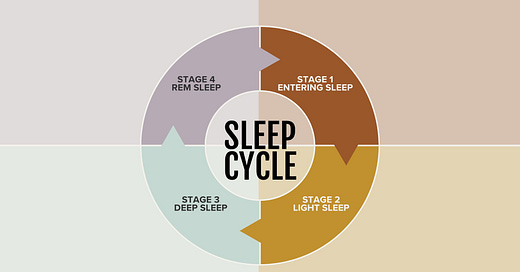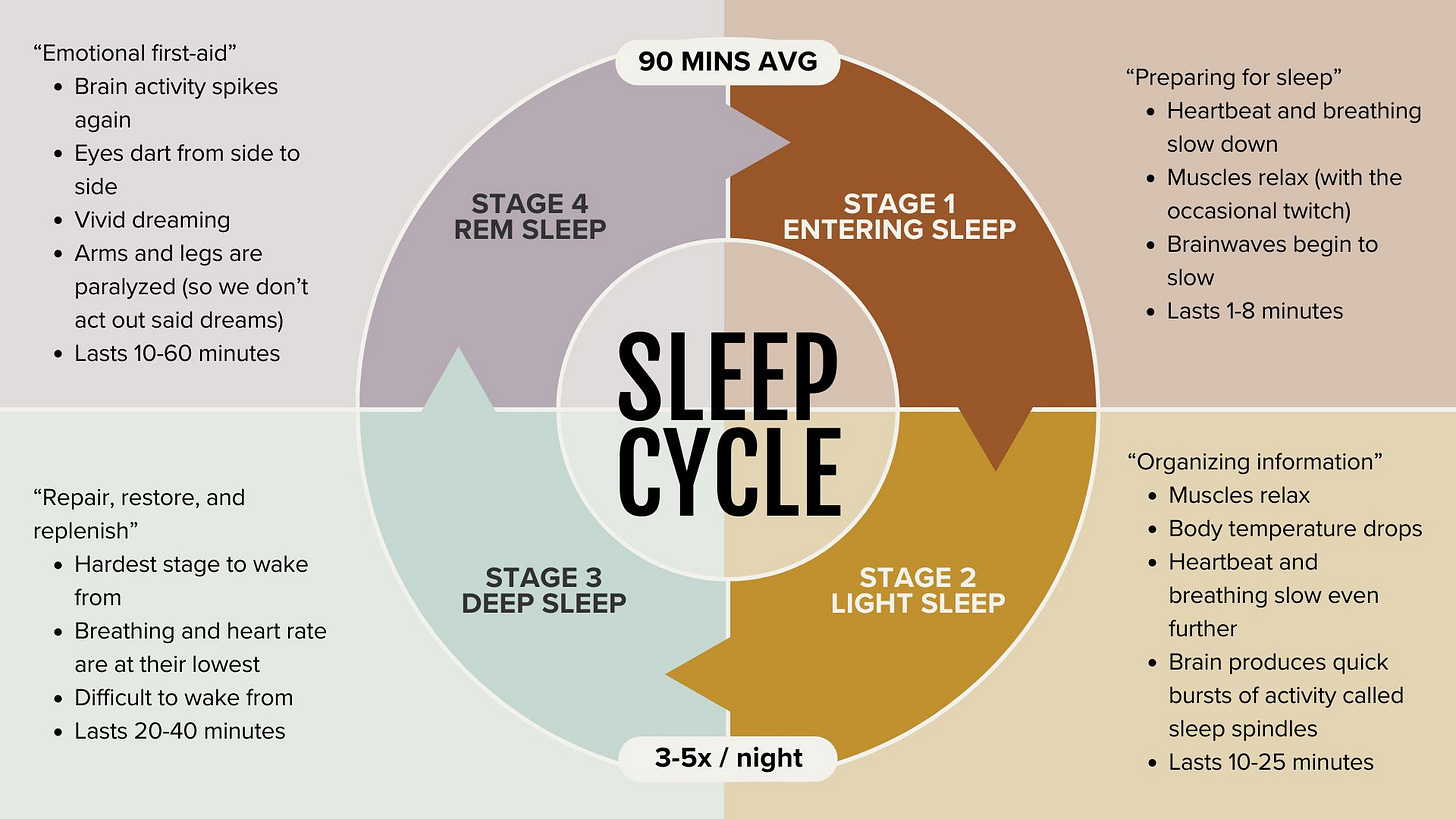Understanding Our Sleep Cycles🛌🏻
Unlock better rest by understanding the four stages of sleep + what they do
We are currently learning about sleep (so we can do more of it) and in my previous post I told you what happens when we sleep: we clean up our mental clutter, consolidate memories, restore immunity, repair tissues, regulate hormones, and process emotions. It’s like housekeeping, therapy, and internal systems maintenance all rolled into one.
But now that we know some of the incredible things that happen when we sleep, lets talk about the actual process that gets us those goods!
You don’t need to be a neurologist to understand your own sleep patterns, tendencies, and needs and — as always — I’ve hopefully over-simplified the info to make it easy to understand and apply.
The Four Stages of Sleep
There are four stages of sleep we cycle through each night — Stage 1, Stage 2, Stage 3, and Stage 4.
Stages 1-3 are considered “Non-REM” sleep — when our eyes are still. And Stage 4 is considered “REM” Sleep — rapid eye movement, or when our eyes are moving (and the stage in which dreaming occurs).
When we sleep, we gently flow from one stage to the next in a sleep cycle that averages around 90 minutes in length — the cycles are shorter toward the beginning of the night and longer toward the end. We repeat this cycle 3-5 times each night. It is an elegant dance of brainwaves, biological processes, and internal healing.
What Happens in Each Stage
Each of the four stages is unique — each has it’s own key indicators, a duration range, and a specific purpose. Here’s a breakdown of what happens in each stage:
Stage 1: Entering sleep
Duration: 1-8 Minutes
Specific purpose: Prepare the body for sleep
Key Indicators:
Heartbeat and breathing slow down
Muscles relax (with the occasional twitch)
Brainwaves begin to slow
This is the lightest phase of sleep. You're still hovering close to consciousness and this is the phase when we often twitch, can be easily awoken, and might ruminate on stressors or racing thoughts.
Stage 2: Light Sleep
Duration: 10-25 Minutes
Specific purpose: This is when our brain sorts and organizes information
Key indicators:
Muscles completely relax (though we may still twitch)
Body temperature drops
Heartbeat and breathing slow even further
Brain produces quick bursts of activity called sleep spindles
Sleep spindles are so cool and are a key element of this sleep stage — spindles help the brain shuffle through all the information you gathered during the day, like a digital file sorter deciding what goes where and what gets discarded.
Stage 3: Deep Sleep
Duration: 20-40 Minutes
Specific purpose: This is when we repair tissues, restore immunity, and deep clean the brain
Hardest stage to wake from
Breathing and heart rate are at their lowest
Difficult to wake from
Stage 3 is the sleep we need to feel truly refreshed. The first half of our night is comprised of mostly Stage 3 sleep. This makes evolutionary sense — it’s like our body knows that even if our sleep is interrupted or cut short, we should still get the essential maintenance tasks done first.
Stage 4: REM
Duration: 10-60 Minutes (gets longer as the night goes on)
Specific Purpose: Emotional first-aid — our brain tries to make sense of confusing, stressful, or emotionally complex experiences and manages neural connections
Key indicators:
Brain activity spikes again
Eyes dart from side to side
Majority of dreaming (especially vivid dreams) occur
Arms and legs are paralyzed (so we don’t act out said dreams)
If something didn’t quite compute during your day — a weird conversation, a difficult decision, a surprising or traumatic piece of news — REM sleep helps your brain file it away, or at least figure out where it might belong. This can sometimes be expressed by our brain through dreaming as it tries to make sense of the day’s events.
Let’s sum it up…
Each night, your body cycles through four stages of sleep:
Sleep Prep mode (Stage 1/Entering Sleep)
Memory & info-sorting mode (Stage 2/Light Sleep)
Deep clean mode (Stage 3/Deep Sleep)
Emotional therapy mode (Stage 4/REM Sleep)
The more cycles you complete, the better you’ll feel the next day. If you’ve ever had your sleep interrupted, you have likely felt the repercussions: Slower to recall information. Food cravings. Emotional or moody. Feeling run down or getting sick.
All of those things can be caused by not completing enough cycles, or having a specific stage interrupted before it was able to complete key organization, consolidation, or replenishment tasks.
Sleep Patterns Throughout Our Life
Any new parent can tell you that a baby’s sleep cycle seems to differ from an adult’s and that they are easy to wake up.
An infant will spend the majority of their time in REM sleep (stage 4), because as we learned, this stage is important for brain development and processing information. As the baby grows, they will start to spend more time in deep sleep (stage 3), which can mean they sleep more peacefully with fewer interruptions. This article has more details on how sleep patterns change month-by-month for infants.
Our sleep patterns also change as we age, with many older adults experiencing lighter sleep with more wake-ups throughout the night. This is because we spend less time in deep sleep as we age. Sleep disruption in older adults can also be caused by chronic pain, anxiety, or frequent trips to the bathroom. Some recent research also indicates that chronic dehydration may play a role in disrupted sleep in the elderly.
Understanding what happens when we sleep and the basics of sleep cycles is the foundation for improving our sleep — something that can fundamentally change various aspects of our life — from our mood and energy to our health and mental acuity.
If you enjoyed this article, be sure to check out the other posts in this series:
🌙 What Happens When We Sleep: Your Brain Is a Messy Bedroom (And Sleep Is the Housekeeper + more!)
💤 Six Ways to Improve Your Sleep: I (mostly) sleep like a baby and these are my favorite ways to optimize my slumber






